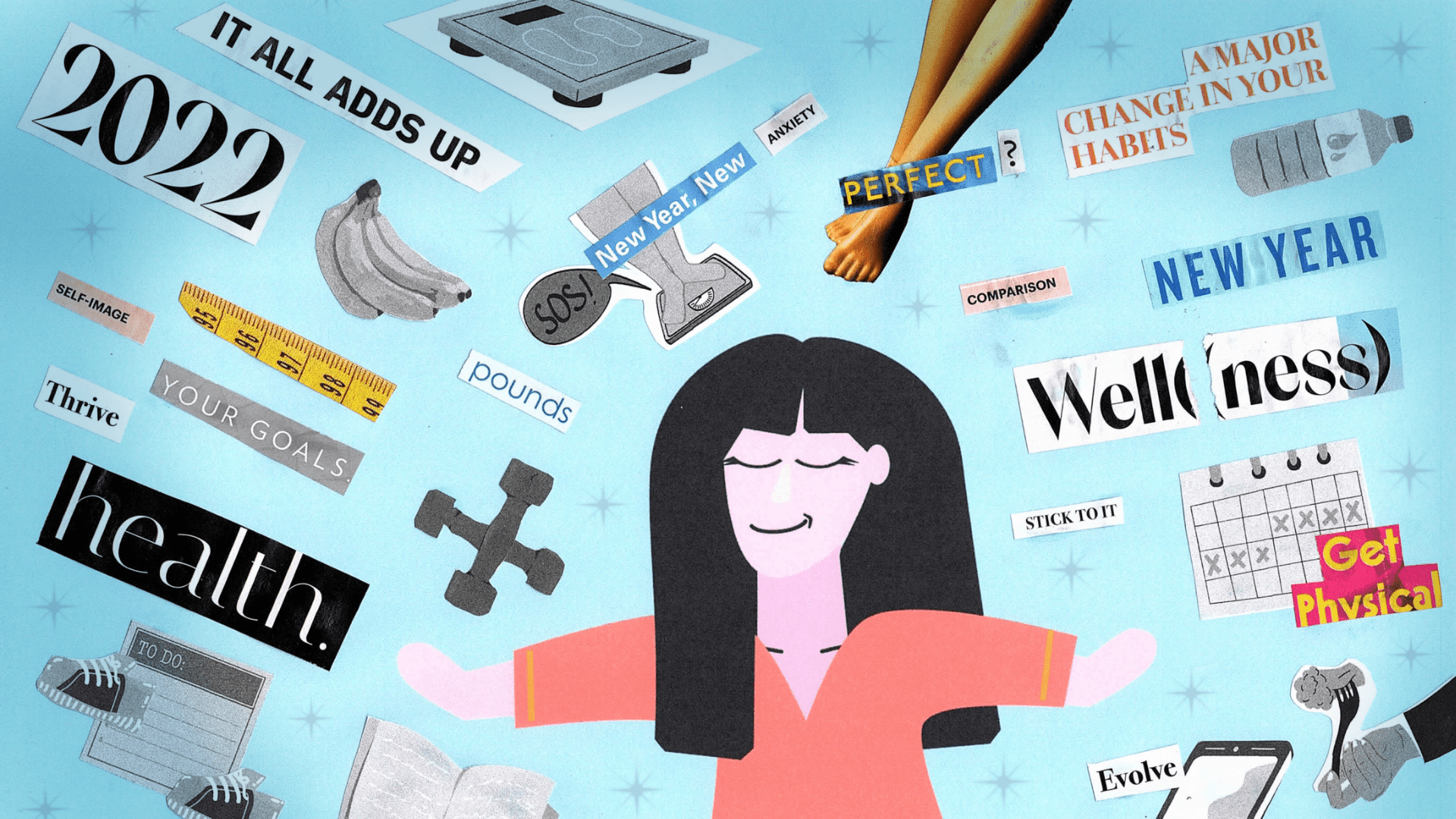
Why I Stopped Setting Weight Loss Resolutions
My sister and her fat positive and anti-diet politics showed me that I should resist weight loss resolutions.
Content Warning: This essay mentions body image issues, weight loss, and disordered eating.
It was my junior year at a co-ed Christian high school where I was surrounded by thin white girls. They always managed to get away with wearing their uniform skirts and shorts a little bit higher than the handbook stated. I, however, was often called out by administrators for wearing uniform clothes in a way that supposedly “revealed” too much of my body.
Surrounded by these peers, my body looked different: chubbier. Though I now understand the administrators’ actions were racist and anti-fat, at the time, I didn’t understand why I was in the wrong. All I know is I became acutely aware of not just my body but the bodies around me. In the process, I began to idolize thinness.
It would take another six years to stop giving in to anti-fatness and diet culture and quit my tradition of setting weight loss resolutions.
But as the clock struck midnight on New Year’s Day in 2015, my only resolution was to change my body. And year after year writing “Lose X amount of weight by X month” became a ritual.
From January 2015 to May 2016, I worked out to fitness trainer Shaun T’s “Insanity” videos once a day. The program focuses on fusing high-intensity interval training and bodyweight exercises together in 20 to 60 minute workout sessions. What makes these workouts “intense” is that you exercise in 3 to 5-minute intervals and take a 15 to 30-second break before you dive right back into your session. Sometimes, when I was alone in my house, I would work out to two or more videos. Part of me suspected it was unhealthy to exercise to multiple videos a day only to have difficulty moving my body because of how sore I was. I’d often tell myself that giving into this suspicion meant giving up.
Instead, what followed was an extreme routine — consisting of over-exerting my body while watching these videos and restricting my food intake — that kept me entangled in a web of my own shame. By January 2016, it had spiraled into a commitment to a fitness style I didn’t want to partake in.
In the mornings, I would weigh myself on the scale in my bathroom, keep that number in my mind throughout the day, limit the amount of food I would eat and work out once I got home from school, hoping that the number would be lower the next day. If that number on the scale didn’t change, I would feel ashamed and disappointed in myself. In my mind, I resolved to work out harder or longer or better (whatever that even means) to lose the pounds I didn’t the day before.
With each passing year, I became so obsessed with wanting to be thin, I would research different exercise videos or phone exercising apps that promised quick results. I jumped from app to video, sometimes combining workouts from two apps into one long session. I took before and after photos comparing my body from the beginning of the year to the end, feeling pleased with how different I looked. When my pediatrician or a family member said I looked thin, I felt a wave of gratification crash over me, assuring me that what I was doing was right.
But no matter how much weight I lost, my body never really changed. I didn’t have the thigh gaps I saw in images on Tumblr or a flatter stomach or less curves. In fact, the weight I’d lose would eventually come back, haunting me anytime I’d take days off from my weight loss routine. What I didn’t know back then was that weight is actually influenced by a myriad of factors such as genetics, race or ethnicity, stress and not getting enough sleep. In fact, weight isn’t actually an accurate measure of health.

Graphic by Maggie Chirdo. Inspiration via adriennemareebrown on Instagram.
But for two years, this cycle repeated itself and I felt like I had no way out. Then when my sister moved back home just as I started my first year at community college in the fall of 2016, everything changed. She began to notice the weight loss routines I followed and advised me to question how it would help me or why I felt the need to continue supporting these habits. For as long as I can remember, my sister has been against anti-fat and diet culture. In fact, for a brief time before moving away for grad school in 2018, she worked at an eating disorder clinic.
While I was busy counting calories and monitoring how much salt or olive oil I’d put into my meals, my sister was at work helping women like me unlearn these habits. All the things she’d learn at work, she’d talk about at home such as how restricting yourself from eating certain foods is unhealthy or how the goal of exercising shouldn’t be about losing weight but for your body to enjoy moving around.
But I was in too deep and didn’t want to let go of the “hard work” I had done to fit into the ideal image of what I thought my body should look like. So I countered and ignored everything she said. I had internalized my high school trauma and my family’s constant comments on my weight made even further damage. Whenever one of my aunts or my mom would say, “Cuidado con ese segundo plato de comida,” my sister would respond with, “Mands can choose what and how much they want to eat.”
Yet, there was always a part of me — especially when my sister defended me or would educate me with links to fat-positive podcasts — that felt a wave of shame for stubbornly holding onto weight loss beliefs. She made me wonder: Could she be right? Can I simply exist in my body and be happy? (Which spoiler alert: it is totally possible but not as easy as it sounds!)
After I moved back home during the beginning of the pandemic in March 2020, I started paying more attention to the ways my sister committed everyday to changing her relationship to her body. Living with her for that brief period of time gave me a new outlook on my habits and rather than give into the messages that claimed I should “lose my quarantine 15” or “start exercising to look better when I emerge from lockdown,” I gradually decided to let go of my weight loss routines.
I stopped looking at exercise as a means to help me lose weight. Instead, I found it helped me manage my mental health. Rather than exercising to workouts that focused on intensity or extremity for the sake of making myself thin (which, scientifically, doesn’t really work), I concentrated on finding exercises that I knew would bring me joy. I did everything from running to walking to stretching to even joining my sister’s evening dance classes sometimes. I even managed to stop weighing myself every morning and counting my calories.
Once I stopped, I realized I had a lot more time to do things that I wanted to without feeling ashamed of how I looked. On some days, I’d notice that I no longer felt anxious about my curves being obvious to others when going on socially-distanced walks or that I didn’t care if my clothes didn’t conceal my chubbiness.
But I don’t want to suggest that it’s always this easy for me, because it isn’t. If I’ve learned anything, it’s that body positivity — which was a movement started by fat women and has since been taken over by thin women — won’t end the anti-fatness bias, the systemic discrimination and harm that fat people face or the cyclical nature of weight loss messaging in our society. In fact, the movement itself has become somewhat toxic.
Instead of turning to body positivity as a source for support on my journey, my sister recommended I turn to Da’Shaun L. Harrison, author of “Belly of the Beast: The Politics of Anti-Fatness as Anti-Blackness” to understand how systemic anti-fatness impacts us all. Reading their work on Blackness, fatness, and the body reminds me that it’s okay to not love or appreciate the body that I’m in everyday, because that’s an untenable framework to move through.
When it came time to write my New Year’s resolutions for 2022, instead of putting in “lose weight,” I wrote in, “Spend this year caring for yourself.” And I’m OK if that means that I’ll struggle to appreciate and love my body because I know that even on those days, I’m resisting anti-fatness and diet culture.

